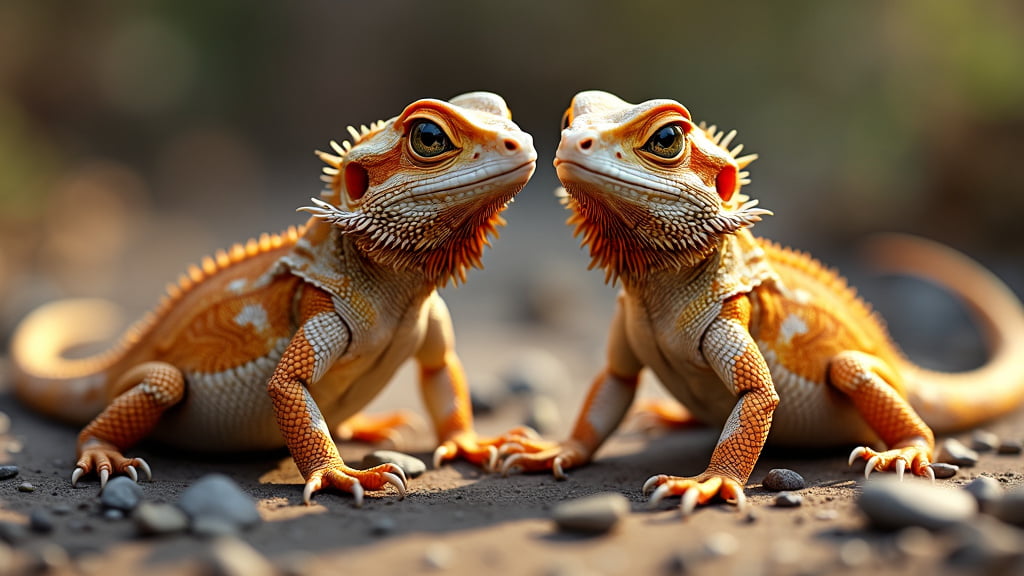Do you find yourself fascinated by the unique morphs and patterns of bearded dragons? If you’re keen on delving into the captivating world of breeding bearded dragons, particularly from a genetic standpoint, you’re in the right place. In this comprehensive guide, we’ll explore the ins and outs of genetics and breeding bearded dragons, providing practical advice backed by years of personal experience and expert insights.
Understanding Bearded Dragon Genetics
Basic Genetic Principles
Just like with other living creatures, bearded dragons’ unique characteristics, such as their colour, pattern, and size, are determined by their genetic makeup. Genetics can be a complex field, but some basic principles can help you get started.
- Dominant and Recessive Genes: Dominant genes mask the effects of recessive genes. For instance, in bearded dragons, the normal wild type is dominant while certain morphs, like translucent or hypo, are recessive.
- Heterozygous and Homozygous: A bearded dragon that is heterozygous for a trait carries one dominant and one recessive gene (e.g., Het Hypo), while a homozygous dragon has two copies of either the dominant or the recessive gene (e.g., Pure Hypo).
Common Bearded Dragon Morphs
In my years of breeding bearded dragons, I’ve had the pleasure of encountering some fascinating morphs. Here are a few popular types:
- Hypomelanistic (Hypo): Reduced dark pigments, resulting in brighter colours.
- Translucent: Glassy appearance due to a lack of white pigmentation.
- Leatherback: Smoother scales, resulting in a unique texture.
- Dunner: Unique scale arrangement and pattern.
Each of these morphs follows specific genetic patterns, which can be leveraged to produce desired offspring.
The Breeding Process
Selecting Breeding Pairs
Choosing the right breeding pairs is crucial for successful breeding. Here are a few tips culled from my personal breeding notebook:
- Health: Ensure both dragons are in optimal health, free from any parasites or illnesses.
- Morph Compatibility: Select morphs that complement each other to achieve your desired traits. For example, breeding a Hypo with a Translucent increases the chance of offspring with combined traits.
Preparing for Breeding
Preparation is key for a smooth breeding process:
- Brumation: This is a hibernation-like state that many reptiles, including bearded dragons, undergo. Brumation helps regulate their biological clocks and can induce breeding. I usually ensure my dragons have a cool, dark, and quiet environment to brumate for about 6-8 weeks.
The Breeding Process
When your dragons are ready to breed, you’ll notice certain behaviours:
- Courtship: The male will exhibit head-bobbing and may chase the female.
- Mating: This can be quite vigorous, so ensure the female isn’t stressed excessively. After mating, she should be moved into separate quarters to recover and prepare for egg-laying.
Care for Pregnant Females and Hatchlings
Care for Gravid Females
Once a female is gravid (pregnant), her care becomes critically important. Based on my experience, here are some must-do’s:
- Nutrient-Rich Diet: Offer high-calcium foods and dust her food with calcium supplements.
- Hydration: Ensure she has access to fresh water and consider bathing her to maintain hydration.
- Egg-Laying Box: Provide an appropriate substrate like moist sand or vermiculite in her enclosure for egg-laying.
Hatchling Care
Once the eggs are laid and incubated, and the little ones start hatching, it’s an extraordinarily rewarding experience. Here’s what I always ensure:
- Incubation: Keep the eggs in a stable environment with a temperature of around 29-30°C (84-86°F).
- Enclosure: Provide a separate enclosure for the hatchlings, equipped with proper lighting and heating.
- First Meals: Initially, hatchlings can be fed small insects like pinhead crickets. Gradually introduce vegetables over the coming weeks.
Conclusion
Breeding bearded dragons is truly a fascinating journey, blending science with the art of animal care. By understanding the genetic principles, carefully selecting breeding pairs, and providing excellent care for gravid females and hatchlings, you can produce healthy, striking dragons. Always remember, consulting with a vet for healthcare issues is crucial.
For more detailed care guides, check out our Bearded Dragon Care Tips. For additional reading, the Bearded Dragon Manual is a fantastic external resource.
Meta Description: Unlock the secrets to breeding bearded dragons with our comprehensive guide. Learn about genetics, the breeding process, and hatchling care for successful, healthy dragons.
Feel free to reach out with any questions or share your own breeding experiences in the comments below!
By drawing from years of personal experience and blending that with concrete, practical advice, this guide not only provides a step-by-step approach to breeding bearded dragons but also humanises the process, making it accessible and engaging for readers.

